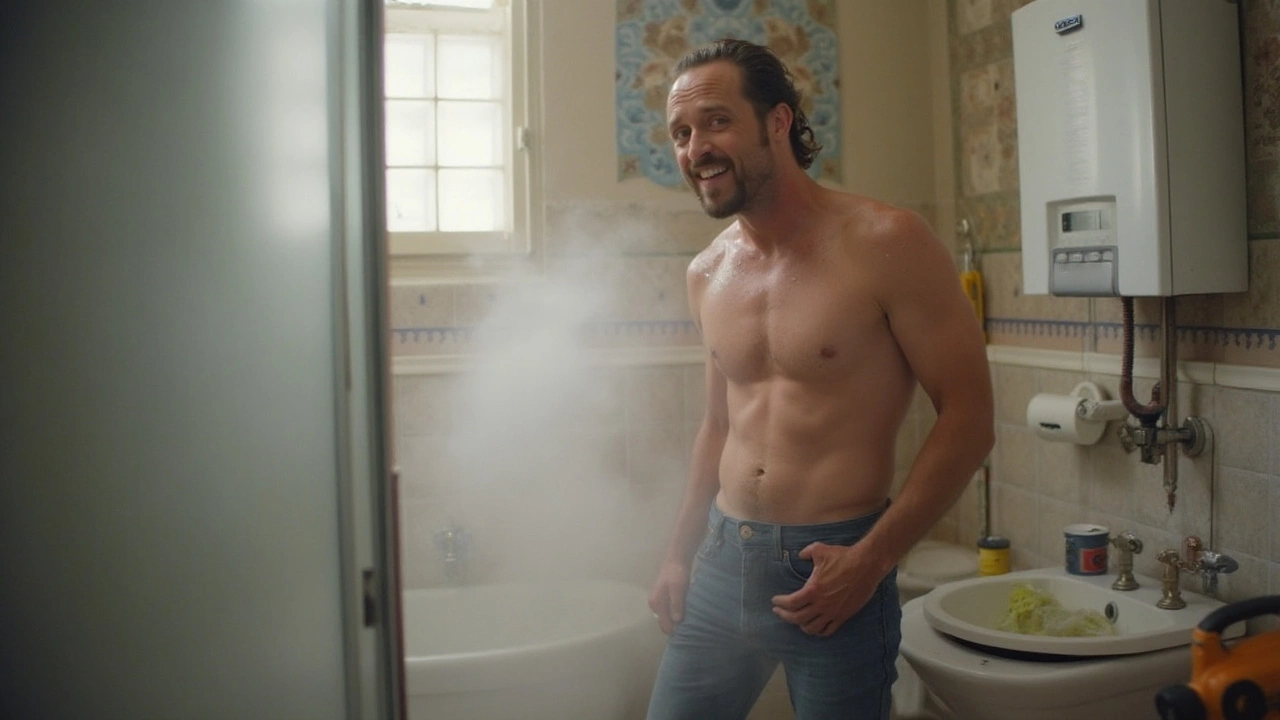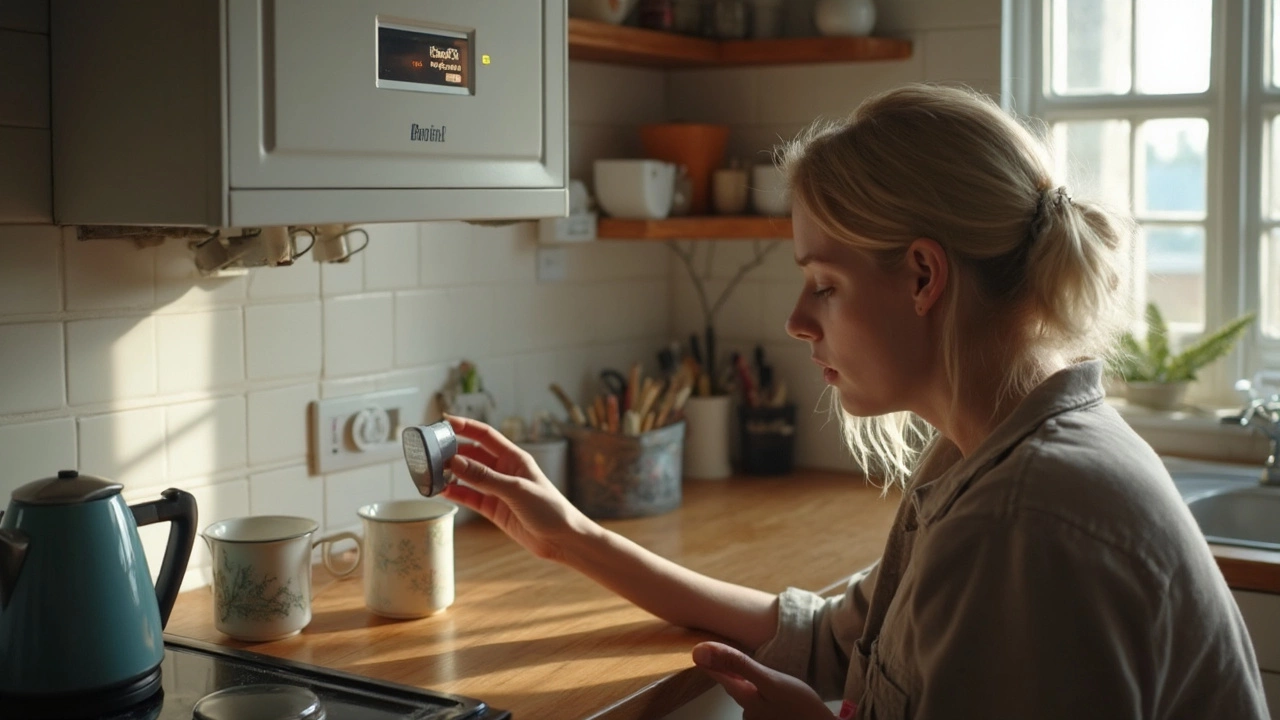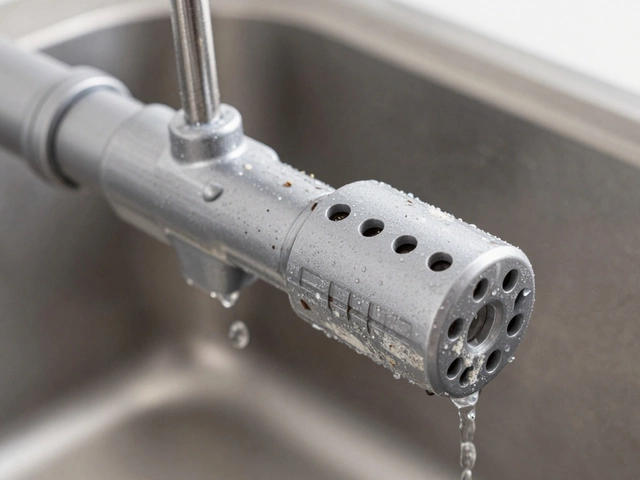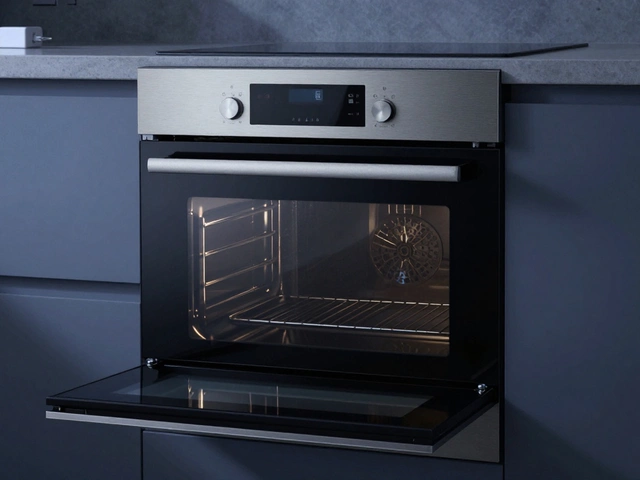Nothing quite compares to the jolt of anticipation ruined by a cold shower. But before dialing up the plumber, it's wise to roll up your sleeves and dive into some basic troubleshooting. Fixing a lack of hot water in your shower often comes down to a few common culprits, and you might just solve the issue on your own.
This guide walks you through the most likely reasons for your shower's chill and how to resolve them without fuss. From inspecting thermostats to addressing sediment build-up, these steps are simple and straightforward. It's a little plumbing literacy that could save you time and money. Whether you're starting your day or relaxing at night, getting your hot water back on track can be a straightforward process with just a little know-how.
- Identifying the Problem
- Checking the Water Heater
- Inspecting Plumbing Lines
- Thermostat and Repair Settings
- Sediment Build-Up Solutions
- When to Call a Professional
Identifying the Problem
When you're faced with no hot water in the shower, it's crucial to start by identifying what exactly is going wrong. A methodical approach can save you a heap of trouble and even prevent unnecessary expenses. One of the most common culprits is the water heater itself. But before we jump to conclusions, let's take a closer look. Start by checking if the issue is isolated to just one shower or if it's affecting multiple faucets. If it's a broader problem, your hot water heater is likely the source. On the other hand, if cold showers are a lone event, it could point to specific plumbing or valve issues in that particular shower.
Once you've determined the scope of the problem, another step is to assess the temperature of the other water outlets in your home. Are you getting lukewarm water instead of piping hot from taps or your kitchen sink? This might indicate an issue with the thermostat setting of your heater. Sometimes, the settings get inadvertently changed, especially in households where the access panel is not safely secured. Elevated electric bills can also hint that something is amiss with your heating system, perhaps straining unnecessarily or leaking energy.
While the typical household may have either a gas or electric water heater, each type has its quirks in terms of operation. For instance, electric heaters could malfunction due to a failed heating element, whereas gas heaters might not ignite properly due to a pilot light outage. According to the Home Improvement Journal, "A majority of no-hot-water cases stem from overlooked issues like tripped circuit breakers or improperly sealed pilot lights."
At this point, gathering a bit more information from the manufacturer’s manual can be commandingly helpful. Most modern units offer diagnostic guides and trouble codes which can shed light on what’s gone awry – especially those with digital displays. Make sure these manuals are handy as you proceed. A digital thermometer comes in handy here too, allowing you to accurately measure water temperatures and compare them against expected outputs. Keeping an eye out for any unusual noises coming from the heater can be another telltale sign of problems, such as scale build-up or pipe obstructions.
If you still can't pinpoint the source, the issue might be with the plumbing itself, requiring deeper investigation into any possible blockages or leaks. Persistent issues, despite all preliminary checks, often warrant a closer look at valves and the integrity of seals. Keep an ear out for plumbing sounds that hint at pressure issues. Stepping into this territory without proper guidance can lead to accidental complications, yet these initial steps often act as your roadmap to bringing back the warmth effectively before professional intervention is needed.
Checking the Water Heater
When there's no hot water in the shower, the heart of the problem often beats in the water heater itself. The water heater is like the silent partner in your home comfort, diligently working behind the scenes. Start by inspecting its power source. If you have an electric water heater, make sure it's plugged in properly and check the circuit breaker. Circuit breakers can trip, especially if you are using multiple high-energy appliances. Simply resetting it might be the quick fix you need.
If you've ensured the power is working, look at the thermostat settings next. Most water heater thermostats are set to about 120 degrees Fahrenheit. Anything less can result in lukewarm or cold showers. Adjust the thermostat gradually and patiently, as changes can take some time to reflect in the water temperature.
Keep an eye on the heater's pilot light. Gas heaters have a tiny flame, known as a pilot light, that ignites the burner. If this light is out, there will be no heat generated. Shower repair is oftentimes as simple as relighting the pilot light. Be sure to follow the manufacturer's instructions on how to do this safely. Here's a little-known fact: only about 10% of Americans are comfortable relighting a pilot light, according to the Home Comforts Weekly.
It's good to also check for any signs of leaks around the heater. The presence of water can indicate tank issues, such as corrosion or a broken valve, which can contribute to loss of hot water. Regular maintenance and check-ups can prevent these problems from escalating. A report from the Department of Energy states that proper water heater maintenance can extend its life by 50%. This simple insight nudges homeowners to not ignore routine checks on their heaters.
If your heater is making odd noises like knocking or banging, it might be competing with sediment build-up. Sediment can settle at the bottom and cause inefficiency or lead to failure. Flushing out the water heater once a year can prevent such problems. This process releases sediment and debris; thus, ensuring the heater works at its best.
If these checks seem daunting, don't worry. These steps are straightforward and only require a few basic tools. Yet, when in doubt, never hesitate to call a professional who can provide an expert diagnosis and solution to restore your home’s water heater efficiency.
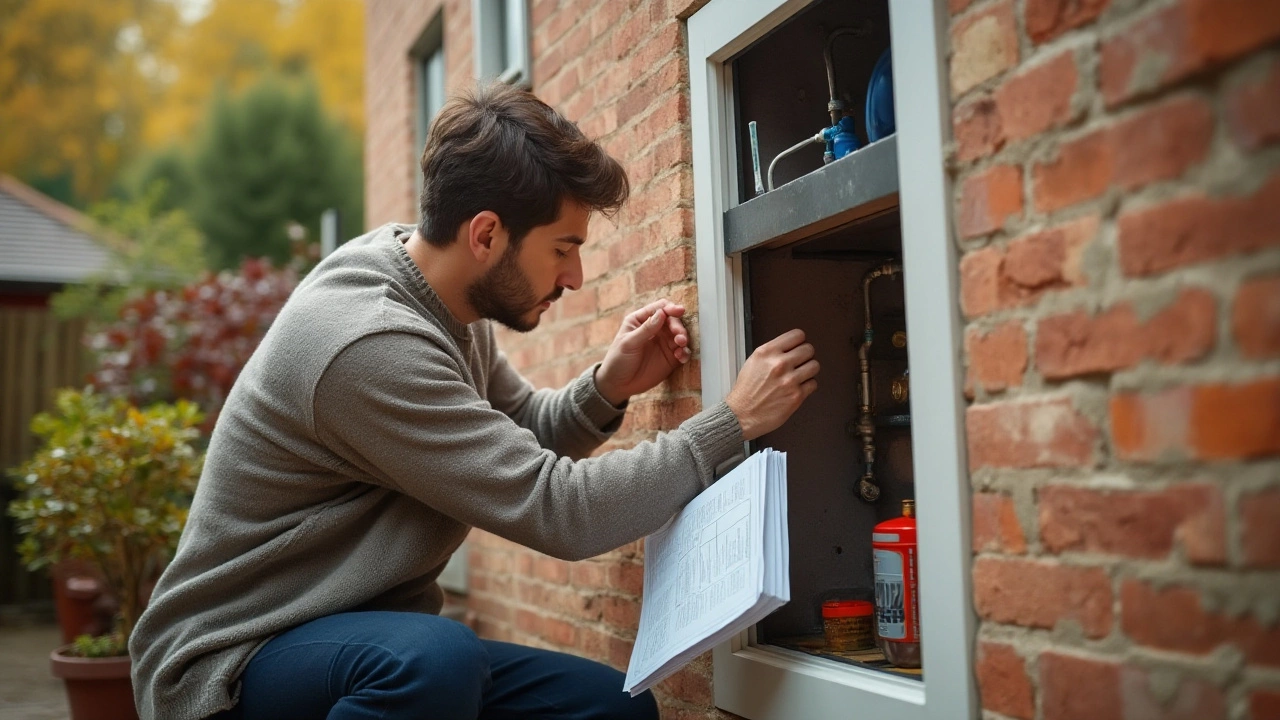
Inspecting Plumbing Lines
When you’re dealing with no hot water in your shower, after ruling out the water heater, the next logical step is to check the plumbing lines. The paths these pipes take through your home can cause unexpected problems that lead to the cold shower blues. It starts with determining whether there’s a blockage, a leak, or something else that’s causing the disruption. The first thing to do is to identify if the problem is localized to your shower or if it's affecting the entire house. Turn on other faucets and compare the water temperature. If they're also lacking in heat, you may be looking at a widespread issue in your plumbing.
Plumbing solutions often reveal problems when you least expect them, so inspecting these lines requires a keen eye and sometimes a bit of patience. A common culprit for such issues is a misaligned valve. Anti-scald devices, which are present in many modern showers to prevent burns, can sometimes cause water to remain lukewarm or cold if improperly set. Ensure these are adjusted accurately. A basic visual inspection can often show worn-out parts or fittings that are no longer working properly.
Another key area to focus on is sediment build-up which can occur within pipes over time. This narrows the lines and consequently impacts water pressure and temperature. Regular maintenance, including flushing out sediment, could prevent such build-ups. If you notice reduced water flow or cold spots, it’s usually a signal that you need to delve deeper into the plumbing maze. Here’s a quick step-by-step to guide you:
- Turn off the main water supply to prevent a messy situation.
- Examine the pipes for visible damage, leaks, or corrosion signs.
- Check all valves to make sure they're open fully and functioning properly.
- Flush out the sediment by running water through the pipes when needed.
"Routine inspection and vigilant maintenance of your home's plumbing can drastically reduce unexpected issues," says home improvement expert Jane Middleman.
Ensuring that the lines are free of corrosion is crucial for maintaining the temperature of your hot water. Over time, both metal and plastic components can degrade, leading to not only temperature problems but also potential contamination hazards. If your lines incorporate elements like copper or PVC, they might react differently to varying water characteristics. Regularly inspecting and replacing them (consulting a professional when necessary) can prevent larger issues down the line.
While these steps will help you uncover potential issues with the plumbing lines, identifying a more hidden glitch might require advanced tools and the assistance of a licensed plumber. It’s important to catch these problems early to avoid more extensive (and expensive) repairs later on. Relying on professional advice when in doubt can make all the difference, ensuring your showers return to their steamy glory.
Thermostat and Repair Settings
The thermostat on your water heater is the brain of your hot water system, dictating the perfect temperature that should flow through your pipes. Often, a simple tweak to the thermostat could mean the difference between a cold dribble and a warm, welcoming stream. It’s a good idea to start by checking your current settings. The thermostat might be set lower than necessary, or it could have accidentally been adjusted during cleaning or maintenance. Generally, a comfortable shower temperature sits around 120 degrees Fahrenheit, providing warmth without the risk of scalding.
Begin your assessment by switching off the power to the water heater to ensure safety. Once you’re safe from potential electrical hazards, remove the water heater’s access panels. You’ll typically find the thermostat tucked just behind the insulation. If the insulation seems damp or excessively worn, that could be an entirely different issue requiring attention, but right now, focus on the settings. With a trusty screwdriver, adjust the thermostat dial to the desired temperature. Don’t forget to check if there are dual thermostats; many water heaters have separate settings for the upper and lower heating elements.
After adjusting, replace the panels and restore power. Let the water heater work its magic for about an hour or so. If the water remains tepid after this, there might be a need for deeper intervention. "When checking your water heater's thermostat, always look for signs of electrical damage," advises renowned energy consultant, Janet Simmons.
"A faulty thermostat can not only cause water temperature issues but also increase energy bills significantly."Should the problem persist, malfunctioning thermostats might be the root cause—these elements degrade over time, their contacts wearing out after countless cycles of heating. In such cases, replacement is often more prudent than repair.
If replacing the thermostat becomes necessary, it's typically a straightforward task for those comfortable with basic DIY projects. Before starting, ensure you have the exact model replacement—water heater components can vary widely between brands and models. Power down the unit once again, and follow a guided plan:
- Disconnect the wiring from the old thermostat carefully, taking a photo beforehand can be helpful.
- Remove the faulty thermostat from its mounting position.
- Fit the new thermostat in place, ensuring a snug connection.
- Reattach the wiring, using the photo as a reference for getting everything in place correctly.
- Restore the insulation and access panels, and power the water heater back up.
It’s these small restorative measures, often overlooked, that hold the power to save time, funds, and temper tantrums when you're seeking a cozy bath. With a touch of patience and a dash of practical know-how, you’re well on your way to preserving hot water harmony in your home.

Sediment Build-Up Solutions
One of the sneaky culprits behind a lack of hot water in your shower is sediment build-up. Over time, minerals like calcium and magnesium can accumulate at the bottom of your water heater, forming a sediment barrier between the heating element and the water. This build-up reduces the efficiency of your heater and can eventually lead to cold showers. Regular maintenance can prevent these issues, and here's how you can tackle sediment with some simple steps.
First, it's important to understand whether you're experiencing sediment problems. If you hear rumbling or popping sounds from your water heater, it's often a sign that there's sediment—including chunks that rattle around as the heater operates. This build-up can also manifest as a drop in the hot water supply or uneven heating performance in the system. Conducting a visual inspection through the heater's drain valve might reveal murky water or visible sediment.
To address sediment build-up, you'll want to try flushing the water heater. Start by turning off the appliance and the cold water supply. Then, attach a hose to the drain valve, directing the other end outside or to a place ready to handle hot, murky water. Carefully open the valve to allow the water to flow out, effectively flushing out sediment. It's wise to proceed with caution, as the water draining could be hot and potentially damaging if mishandled. Once cleared, close the valve and refinish the water supply.
For homes in areas with hard water, installing a water softener can help prevent future sediment issues. Hard water contributes considerably to mineral accumulation, so addressing this root cause can save you potential repairs down the line. Installing a softener system is an investment that pays off, keeping plumbing and heating systems running more efficiently and extending the lifespan of appliances.
Another practical approach is to make this flushing process part of your home maintenance routine. Depending on the water hardness and heater type, performing this flush every six months to a year keeps sediment at bay. Not only does it prevent hot water issues, but it can also improve the heater's lifespan by maintaining optimal functionality.
John Anderson, a seasoned plumber, once said,
"Regular maintenance is the key to extending the life of your water heater. A little attention now can prevent significant issues later."This advice rings especially true when dealing with sediment. Ignoring sediment build-up is akin to letting a slow leak become a flood.
Sometimes, if the situation is severe or if you're uncomfortable flushing the heater yourself, consulting a professional might be your best bet. Water heater inspections and tune-ups from experienced hands ensure that nothing is overlooked, keeping your shower repair solutions both effective and safe.
When to Call a Professional
There comes a moment, perhaps when you’ve exhausted all options in resolving your hot water issues, when you need to recognize the time to step back and allow a professional to step in. It's important first to appreciate that not all problems are within the average homeowner’s capability or safety parameters to solve. Your time and safety are valuable, and sometimes professional help is the best route to take.
For instance, if you've checked your water heater and it's no longer under warranty, or if you notice rust or corrosion around the tank, it might signal replacement is needed. A professional will be able to accurately assess whether repair is possible or if a new unit might be the most effective solution. This is especially true if your system is older. Usually, water heaters have a lifespan of about 8 to 12 years. Beyond that, the efficiency decreases, and it’s worth getting an expert's opinion.
Another cue is the presence of any strange noises coming from the heater. Rumbling, popping, or high-pitched whining sounds can indicate sediment build-up or potentially more complex mechanical issues. These are not just about comfort but can impact the safety of your home if left unaddressed. Handling electric components or potential gas leaks should strictly be in the hands of experienced professionals, reducing risk and ensuring compliance with local building codes.
If any part of your plumbing system seems beyond simple tweaks or the water is either scalding or too cold despite attempts to regulate, calling a pro is a wise move. Thermostat issues or complicated electrical wiring can often be the culprits, and these require specialized tools and knowledge. As Jeremy Lowry, a respected voice in home repairs, says,
“Sometimes the smartest tool in your toolbox is actually the expert you know to call. Don't risk it when safety is on the line.”
Sometimes, efficiency can be measured by modern solutions that a professional can recommend. Energy-efficient water heaters, for instance, might offer rebates or benefits for eco-friendly homes, and a professional can guide you through models that save energy and reduce bills. Essentially, certified experts keep up with the evolving standards and products on the market, making sure you get not just a fix but possibly an upgrade at a much better value.
Plumbing solutions can sometimes demand permits or inspections which professionals are familiar with, ensuring you’re not inadvertently violating any regulations. It’s always beneficial to have a licensed professional involved in such scenarios. In fact, in areas like Washington, D.C., or New York, some water heater repairs are mandated by law to be performed by professionals. This is not just about safety but about adhering to legal standards that might otherwise land a homeowner in inadvertent legal trouble.
Most importantly, consider the hours you’ve spent attempting to solve the mystery of your shower. Time is precious, and sometimes professionals can solve in mere hours what might take you far longer. They also offer guarantees for their work, which could include follow-up visits should the problem persist, giving you peace of mind that your investment isn't just a temporary fix, but a long-term solution.
